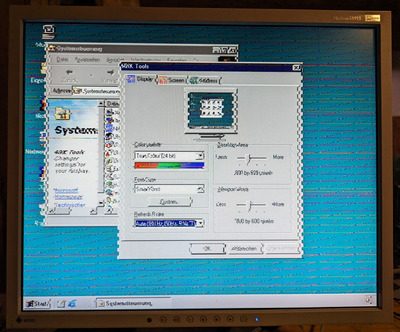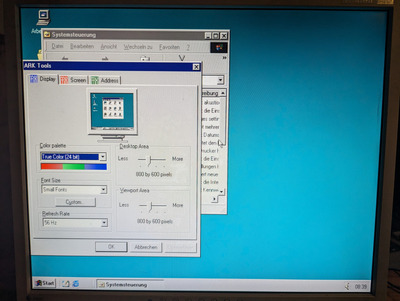CoffeeOne wrote on 2023-10-29, 08:22:UPDATE:
I ran Wintune 2.0 with 800x600 24bit 56Hz.
It gives about ~1950kPixel/sec. That is super slow.
With 800x600 16bit 72Hz i […]
Show full quote
UPDATE:
I ran Wintune 2.0 with 800x600 24bit 56Hz.
It gives about ~1950kPixel/sec. That is super slow.
With 800x600 16bit 72Hz it is ~6700kPixel/sec.
This shows that the memory interface of the ARK1000 is at its limit:
800x600 24 bit at 56Hz requires 110MB/s sustained transfer rate. 800x600 16 bit at 72Hz requires just 94.5 MB/s. At 110MB/s, there is nearly no bandwidth left for the CPU to draw pixels. The 60Hz mode requires 120MB/s, and as you screenshot shows, the card is unable to reliably provide that data rate at all, even if no drawing operations take place.
To increase the memory bandwidth of the ARK1000, you need to increase the memory clock. I suspect the fast page-mode burst rate of the ARK1000 is 2 cycles per 32-bit word. At a clock of 55 MHz (the original clock of feipoa's card, IIRC), this would be 110MB/s theoretical maximum, which explains why this is insufficient for 1280x1024 @ 60Hz, which requires 110MB/s continous practical throughput. As your card is able to just deliver 110MB/s, but fails at 120 MB/s, I assume your card uses a memory clock of 60MHz or 65MHz.
The issues we are facing at 800x600x24 and 1280x1024x8 NI are not due to sloppy programming that can "just be fixed" by fixing the BIOS or graphics driver, but this is at the very limit of the hardware limits of the ARK1000 architecture.
The ARK2000 has much more capacity than the ARK1000: It has a 64 bit memory interface, instantly doubling the throughput, and as the product brief indicates, it has specific EDO support, which might provide 1 cycle per 64-bit word instead of 2 cycles per 64-bit word. I don't know whether this is actually true for the ARK chips, but I know for sure that S3 introduced a "single cycle EDO mode" with the Trio64 or Trio64V+, so it is likely the competition did alike.
[/quote]
CoffeeOne wrote on 2023-10-29, 08:22:
But still: If I would get this mode running stable without flickering, it is not very interesting for me.
The flickering is most likely not due to the graphics card, but due to your monitor, deciding that there is "no signal" if the vertical frequency is below 56Hz, and you just hit the limit of that monitor. Check whether you have any kind of SVGA CRT (standard VGA is not meant to synchronize to 35kHz), and whether you can reproduce the flickering there. If the mode works fine on a CRT, but flickers on your CRT, a BIOS patch that reduces the blanking time will help. With reduced blanking, you will get slightly higher refresh rate at the same dot clock / data transfer rate.

